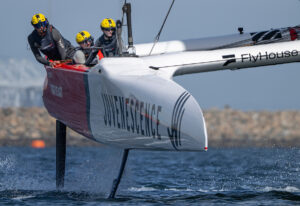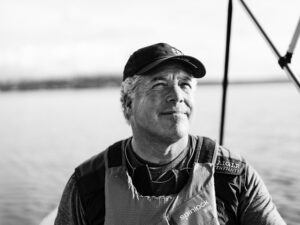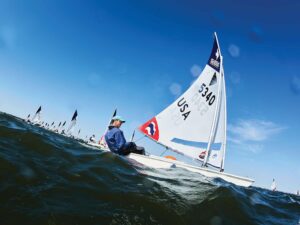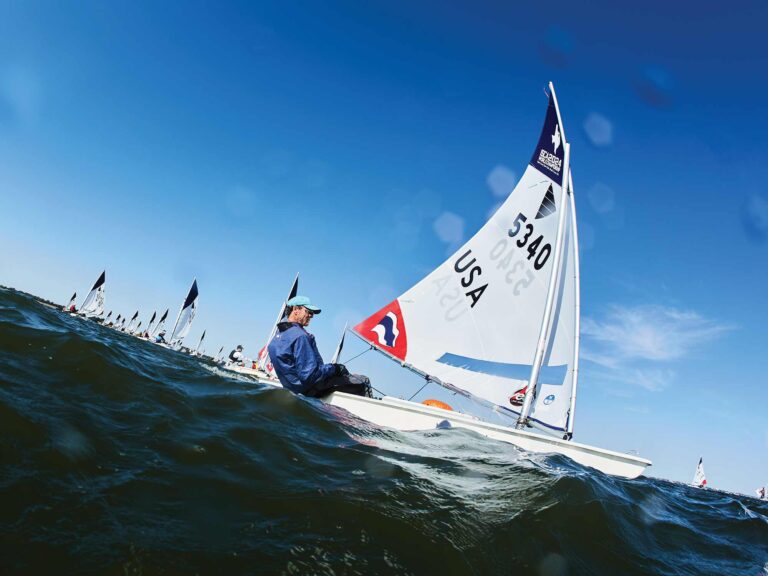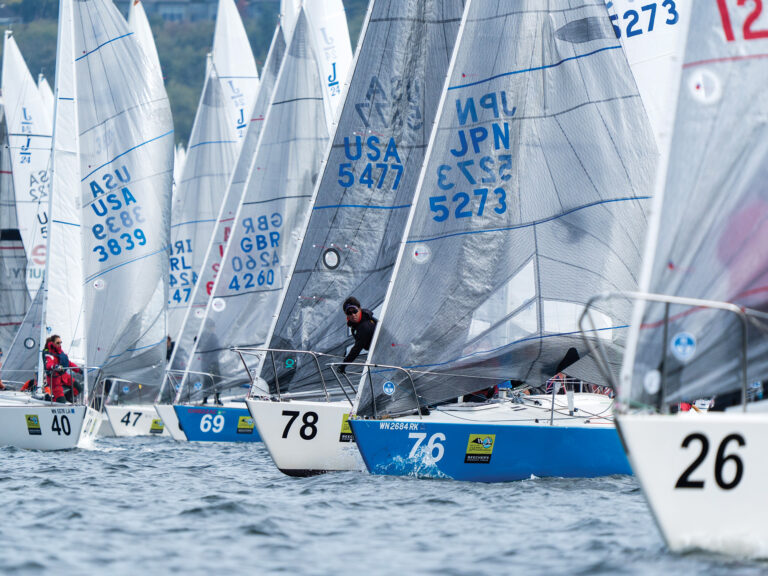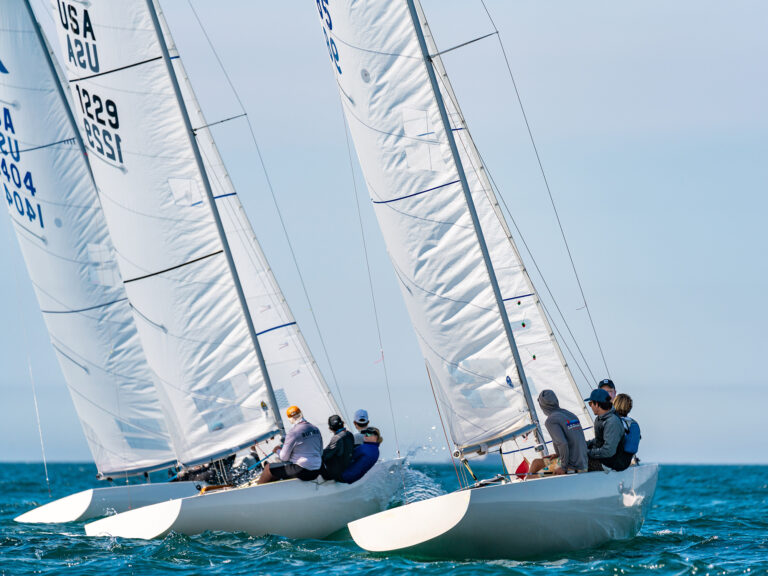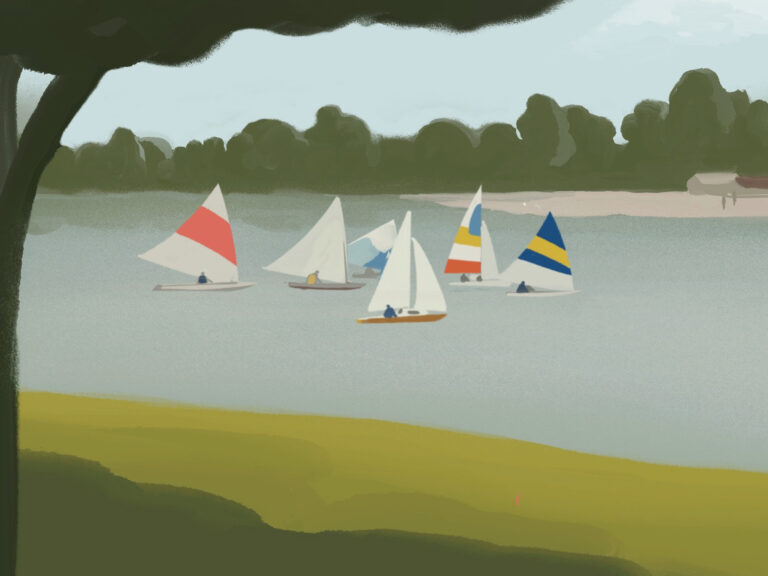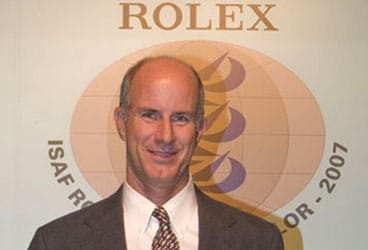
Ed Baird 368
What’s the 32nd America’s Cup winning helmsman to do after nearly two years of high-stakes in-house scrimmaging and testing and then prevailing in the closest Cup match ever contested? For Baird, the 50-year-old professional sailor from St. Petersburg, Fla., one obvious means of decompression was an excursion that would take he, his wife, and three children as far as possible from anything remotely connected with the Auld Mug and the stress of its defense. Alaska beckoned, and off they went. On one particular day of their 10-day RV romp through the 49th state, says Baird, he did find humor in the sudden change of pace while wrestling with the effluent discharge hose of their rented motor home; nothing like tuning up and AC boat. But today, as the Cup’s legal proceedings grind on in the U.S. courts, Baird continues to train with the team for what he says will be a Cup match unlike any before it.
The Baird family RV trip; I never would have seen that one coming.
It was one of those things we’d never been able to do, always wanted to, and decided it was the time to do it. After that we had to get reestablished; we had to get the car, buy a boat, and get back all the things that we’d divested ourselves of previously and get back into life at home. The kids are sailing and we’re getting back to things like fishing, and seeing friends we hadn’t seen in years.
Then last November you get the ISAF Rolex Sailor of The Year; was that a surprise?
It was. There was a huge amount of success by various people and while I was honored to get the award, I was surprised it came down to me. You just never know how it will go; it seems a lot of folks around the world thought what we did [with Alinghi] was special and it was the reward for that effort.
In my case it’s something that’s personal and satisfying, but it’s not something I’d try to flaunt or do any kind of a media tour with. Since I’ve been back in Florida I’ve had a lot of other opportunities to spend time around the kids doing Optis and high school sailing and stuff and it’s nice to have recognition in their eyes.
Speaking of awards; first you and then it’s Tampa’s Jeff Linton getting the Rolex Yachtsman of the Year. Is there something about Tampa Bay that makes you guys so good?
We’re lucky where we live that there are a lot of folks who put a lot of time and effort and have gotten to very high levels, and in a way it’s more laid back and casual. Down here no one’s burning out on the sport because there is so much else to do that our attitude toward sailing is more relaxed. It’s there when you want to focus on it, any time of the year.
You’re back onto the Optimist sidelines these days?
The kids are 10, 12, and 15, and I’m trying to help them out if I can, but I still have a lot of travel and stuff with the Cup team. I love to get to the events with them, get them set up, push them off the beach, and stand there with the rest of the Opti parents. I just try to give a hand where they need it, but they have coaches and they need to go out and learn on their own. The one thing I can do when they’re frustrated with something they’re not familiar with, or not comfortable with, I can cut the corner for them by offering suggestions. They need to make their own mistakes; once you’ve made it, it’s easier to see it coming along next time.
With regard to the 33rd Cup, have you been involved in any of the legal proceedings?
The sailing team has been virtually completely removed from it all. We’re all disappointed we’re in the situation we’re in because we were all excited to have another event in two years time and it would be well attended with the dozen teams ready to go; some teams were still sailing in Valencia. So it was all getting ready to happen again with lots of teams and a new kind of boat. It was exciting, but now things have changed direction. But we’re ready to get cranked up again and see what we can learn about multihulls.
How would you have liked to see the Cup transition to the next event?
One of the big problems of the past 20 years was the starting and stopping; you get started with the Cup cycle and then there are four or five years until the next event. One of the great things about the last cycle was the Acts. It forced teams to start earlier and forced everyone to take it to a higher level of professionalism that went really well for the overall event; it was closer in the end than it had ever been. The concept was to build on that, but now it’s something totally different.
Was it time to ditch the America’s Cup Class?
Oh yeah. It was time to change the boat. In one sense it was very close, which made it very exciting, but in another sense the America’s Cup Class was well behind other parts of the sport that were capable of pushing the envelope a bit more, and that’s what the Cup has always been about so it was time to make that change and move on. One thing a lot of people forget is that if we’d gone on with these boats through another Cup cycle the class would be approaching 25 years old. That’s ancient in today’s world.
At this point we know it’s a multihull, but is it a catamaran or a trimaran?
The best we can figure out, we don’t know what they have, and the best we can figure out, they don’t know what we have. We just have to go and put our best hand forward, try and figure what makes the most sense and gives us the best option, and see what that is. At this point in time, we don’t even know if we can race. When the judge comes back and tells us when it’s going to be, then we’ll know whether we can race or not. There are a lot of questions, but we’re pushing ahead. It could very well happen that what we come up with doesn’t work out in the end, but we’re trying.
Is this why you’ve been sailing both the Extreme 40 catamarans and the ORMA 60 trimaran?
We’re trying boats that are the size the next Cup will be in; the Extreme 40s are big enough and the ORMA 60s are close, and they both have characteristics that are special and good for situations on the racecourse, so we have to go out and find out what those are and find out the possibilities. Hopefully we’ll be good enough to go and beat these guys up once the Cup comes around.
You haven’t exactly done much multihull sailing have you?
I have actually, but never on these big offshore type multis. Most of the guys have some time in a cat or tri of one sort or another. It’s definitely different, and we have to figure out the things that will help us win in those unique boats.
What have you done to brush up on the skills you need?
I just jumped right into it. It definitely is a different mindset where you have to think faster and react quicker in certain ways, but on the other hand, because the boats are so fast, you have to think a lot further ahead of yourself-and a lot sooner-for things to happen on the racecourse. In that sense it’s a process of slowing the whole race down and play out ahead.
Time to put you on the hot seat; what happened when you guys capsized the ORMA 60 trimaran earlier this spring?
Well, the fine details are proprietary to the team and that’s the way things get done in the Cup. But I can tell you that we did a bear away and things went wrong. I was driving, it was blowing in the low 20s, and there was some swell on top of the waves that the wind was generating, and we were simply bearing away. We weren’t pushing hard by any means; it was just a normal bear-away and it didn’t work. It was quite amazing how quickly it happened, every bit as amazing as a Hobie 16 pitch pole.
Some of the guys went into the water right away, some held onto whatever was next to them. I got hold of a stanchion and hung on for a while; once the mast broke everyone was swimming. Unfortunately a couple of guys got hurt and we’re sad about that. We’re particularly disappointed that the equipment wasn’t ours. But everyone was understanding of it, and the boat’s getting fixed up; it’s not the first time this boat has been upside down. It’s the third time from what I understand. We learned a tremendous amount from it, I don’t wish it on anyone, and I hope it doesn’t happen to us again, but the fact that it did, taught us a lot.
What did you walk away having learned?
Things I can tell you in about 18 months when the Cup’s finished.
OK, so let’s say the match is eventually sailed in big trimarans; and based on what you’ve learned so far, how will it change the game of match racing, as you know it today?
The game gets faster with regard to laylines, mark roundings, and positioning against your opponent. Things happen fast when you’re against each other, but the game takes the same amount of time; you have to make sail calls several minutes out, which is now more distance out, but in the end, they’re boats, and if they’re pretty close in speed it will be a close race, but if one is faster than the other then it won’t be.
The subtleties of the match-racing maneuvers must be textbook in your head by now, but this next match has got to be different.
Sure, the equipment is different and the apparent wind is really far forward when you’re going downwind, so it’s a whole different deal, but it’s not that far of a step from the sport boats and skiffs that we sail on the match-race tour events. It’s not foreign; you still have to sail the boats and make the best of the conditions.
Are big multihulls something match racers really want?
I think that everyone’s excited about learning new equipment, boats, and the stuff that goes along with that. We like improving ourselves every day and we have a challenge in front of us because of this. In many ways it’s not a traditional America’s Cup to have two very similar boats that are very close in speed and have a very technical race against each other. This will be totally different, with big splits and speeds that are much different than the past; it will be much different.
These multihulls require a different type of sailor than what you might pile into an AC boat; does this change the crew dynamics at all?
There will be some differences, but it won’t be dramatic. You still need some big strong guys to make things happen on board. One thing that is maybe far out of people’s minds is that these boats are monsters and will be really hard to tame and to control; they’re so big and powerful that nobody has seen anything like this before. Boats this size race across the ocean but they’re set up for all-purpose type racing. We’re talking about boats this size set up for short-course day racing. It will be a different tool.
Will the racecourses be different?
Yeah. There won’t be any leeward gate or anything like that. The start, while it is important, it’s not going to be everything. You take off on the start for a 20-mile beat and you’ve got plenty of time to make up for being 3 seconds late off the line, for instance.
During all the prolonged legal action, what’s been the effect that you see on the sailors?
The sailors that are active on the squads that are waiting to go racing are obviously disappointed, but it is what it is, so we’re trying to prepare to try and win the next event. For the people who were on other teams it’s been really sad because here we have this great potential for an event in 2009 and that got shot down. Hopefully we’ll keep moving towards having an event in three years with a bunch of teams.
Are you confident there will be another match like the 32nd?
In recent history, when anything like this happens, the group of folks that have the greatest stake in it get together and figure out how to avoid something like this in the future. I expect that to happen as things go forward. The Cup is special and unique; it’s not just a notice of race, it takes a challenger and defender to get it started and then everyone else gets included. That’s what makes the event special and hopefully we can be smart about how we do it and have it be the great show that it can be.
So for now, you’re living and Florida, but training in Europe.
I have to do a lot more traveling and it will become more frequent as we get closer to having a boat that we can go and learn on. And then it will get real serious when that boat gets on the water and is ready for racing. There are other opportunities to go racing and our plan at the moment is to get the 40s on the circuit in Europe and learn more about the race process in these faster boats. You can’t do everything, especially with a family, so we have to make choices. Every day we have to ask ourselves, “How is this going to help us win the America’s Cup?” If the answer is that there’s not much value there then you have to think twice. The focus is on the big boat and making sure it’s designed and built and sailed properly when it’s on the water.

